One of the latest mysterious ciphers to reveal its secrets is the Copiale cipher, thought to have been written around 1742-1760 by The Great Enlightened Society of Oculists [aka the ‘high enlightened (Hocherleuchtete) oculist order’], an early Freemasonic society.
One by one some of the greatest unsolved ciphers, such as the Voynich manuscript, the fourth passage on the CIA’s ‘Kryptos’ sculpture by Jim Sanborn, and the Beale papers, are being submitted to analysis by modern computer techniques and natural machine language algorithms.
The Copiale cipher was cracked in 20111 by an international team consisting of Kevin Knight, of the University of Southern California Information Sciences Institute and USC Viterbi School of Engineering, Beáta Megyesi, and Christiane Schaefer, both of Uppsala University in Sweden.
Discovered in the East Berlin Academy after the Cold War, the Copiale cipher consists of an elaborately bound volume of 105 pages of gold and green brocade paper, bearing some 75,000 characters comprising 90 distinct symbols — a perplexing mix of Greek and Roman letters, and pictograms.
The name of the cipher comes from one of only two non-coded inscriptions in the document.
During the early days of Freemasonry, it was common for secretive societies to encode their rituals on parchment in order to protect them from the uninitiated.
Beyond basic privacy concerns, this was deemed necessary owing to Pope Clement XII’s 1738 prohibition against Catholics joining secretive orders, religious organizations, and governments.
He further discouraged all Europeans from affiliating with such groups by alleging that the followers of these secretive orders were practicing satanic rituals.
In response to his edict, secret societies began using encoded documents to protect themselves and their membership from persecution. [2]
Many secret societies created rite and rituals which they could use to pass on ideology in coded language, thus hiding themselves from persecution of those with religious or secular authority and power.
The ideals of these groups were the influence upon more democratic policies across North America and Europe – one such example being the American Declaration of Independence which included the encoded beliefs of some of these societies.
Due to the underground nature of certain groups, the Great Enlightened Society of Oculists [GESO] was misunderstood for centuries.
They were viewed as a strange gathering of mysterious optometrists, men with a pathological fascination of the human eye.
However, their true ideology was passed on in an encrypted text, veiled in Greco-Roman letters and ciphers, which remained undeciphered for 250 years.

Coat of Arms of Friedrich August von Veltheim founder of the Oculists
IMAGE LINKED: wikimedia Attribution 4.0 International (CC BY 4.0)
In places, the Oculist society cipher reads like a revolutionary manifesto, describing the order of rule and governance of monarchies as a three-headed monster that deprives man of his natural freedom. [3]
In a social landscape ripe for secret societies offering safe haven to newly developing scientific and political ideas, the GESO was anything but preoccupied with professional endeavours of an ophthalmological nature.
Hidden within this social construct, the GESO offered a unique breeding ground for new thoughts and enlightenment ideals and appears to have had an attitude towards allowing female members that was surprisingly progressive for its time.
According to Noah Shachtman, former writer for Wired magazine:
Though they were clandestine, they were often remarkably inclusive.
Many welcomed noblemen and merchants alike—a rare egalitarian practice in an era of strict social hierarchies.
That made the orders dangerous to the state. They also frequently didn’t care about their adherents’ Christian denomination, making these orders—especially the biggest of them, Freemasonry—an implicit threat to the authority of the Catholic Church.…
These societies were the incubators of democracy, modern science, and ecumenical religion.
They elected their own leaders and drew up constitutions to govern their operations.
It wasn’t an accident that Voltaire, George Washington, and Ben Franklin were all active members.
[4]

The Great Enlightened Society of Oculist’s coin features a cataract needle, a pince-nez, and two cats watching over mice, perhaps alluding to the oculist belief in sight as a metaphor for knowledge.
Publicly, members of the GESO performed eye surgeries, boasting in their public bylaws that we exceed all other healers by being able to pierce cataracts, only those with a ‘light hand’ need apply, a phrase used in their public bylaws and also in their secret cipher as a reference to their member’s surgical skills.
Describing themselves as gatekeepers to the burgeoning field of ophthalmology, they wished to keep out all charlatans who preyed on unsuspecting patients, as they openly declare in their cipher.
The cipher depicts the initiation ceremony for hopeful apprentices. Surrounded only by candlelight, the candidate has to lower himself onto a taboret (a low stool or small table) and look upon a seemingly blank piece of paper.
If, after a while, he answers that he cannot see anything written on the paper, the Master of Ceremonies places a pair of eye glasses on the candidate and again asks him if he if he is able to read any writing.
The candidate replies that he still cannot see. The Master of Ceremonies comforts the candidate, raising his hopes for improvement by washing his eyes with a cloth, stating that if this doesn’t help, he will announce to the lodge that they have to proceed with an operation on the candidate’s eyes.
The candidate is told not to panic; there is still hope that his vision may improve.
The Master wearing an amulet with a blue eye in the center selects a pair of tweezers from the table.
The members in attendance take up candles and place themselves around the candidate.
Noah Shachtman (Wired, 2012) describes part of the ritual:
The master starts plucking hairs from the candidate’s eyebrow.
This is a ritualistic procedure; no flesh is cut, but the master assures the candidate that these are ‘symbolic actions out of which none are without meaning’, the candidate then places his hand on the master’s amulet with the master telling the candidate to try reading the paper once again while surreptitiously replacing the blank page with another filled with handwritten text.
‘Congratulations, brother!’ the members say, ‘Now you can see!’ The candidate can now read the text of the oculist society pledging allegiance and completing this secret initiation.
Source: ‘They Cracked This 250-Year-Old Code, and Found a Secret Society Inside’ https://www.wired.com/2012/11/ff-the-manuscript/
Dr Andreas Önnerfors, Worshipful Master of Quatuor Coronati No. 2076 in 2020, is Professor in the History of Sciences and Ideas at University of Gothenburg, Sweden.
In his paper, ‘Unveiling the Copiale-manuscript: layers of fraternalism, ritual and politics in eighteenth century Germany’,5 Önnerfors breaks the Copiale Cipher into five sections:
• Oculist-Order, p. 1-27
• Masonic degrees I-III, p. 27-68
• Scottish Master, p. 68-99
• ‘Key lodge’, p. 100-104
• Alchemical lodges. 104-105

Copiale Cipher – 18th century – Kevin Knight, Beáta Megyesi, Christiane Schaefer, Public Domain
IMAGE LINKED: wikimedia Attribution 4.0 International (CC BY 4.0)
The first section describes the initiation and degree ceremonies of the ‘Highly Illuminated Order of Oculists’.
Önnerfors writes regarding the other four sections that:
‘Since the most “secret intention” (p. 25) of the Oculist Society is actually to expose the secrets of Freemasonry, pages 27-105 are devoted to a thorough description of various ‘mainstream’ freemasonry degrees: (apprentice, fellow and master’s on pages 27-68, the Scottish-master degree on pages 68-99, the so-called “Key lodge” (apparently a deviant continuation or variety of the Scottish masters degree) on pages 100-104 and a so-called “Consolation lodge” practicing alchemical workings on page 105.’
As Masons, we are well acquainted with the first three degrees, so no explanation is required.
The Scottish Master degree is considered the original fourth degree, similar to the Royal Arch in Britain, and is a narrative continuation of the Third degree.
The first theme of the Scottish Master degree is the rediscovery of the lost Master’s word found in the debris of Solomon’s Temple (during Christian mediaeval times).
The second theme is Hiram’s identity as a priest with access to the Holy of Holies. The candidate is purged with water as a Levite and is granted access.
Hiram is, according to different versions of the legend, buried in the Sanctum Sanctorum.
Around roughly the same time another degree is developed, ‘Maître èlu’ – Selected Master.
This degree centers on the discovery and punishment of Adoniram’s murderers. Adoniram was the tax collector in the Kingdom of Israel for over forty years, from the late years of King David’s reign until the reign of Rehoboam.
According to the biblical narrative, he was stoned to death by the people of Israel when Rehoboam sent him in an attempt to collect taxes (1 Kings 12:18). [6]
The Selected Master degree is later placed in between section three and the original fourth as an intermediate theme.
Section four turns into degree five or six, thematically demonstrating clear chivalric and sacerdotal (priestly) motifs.
The main theme of the Schlüsselloge (Key lodge) is that tyranny has taken natural liberty from man; the Freemasons/Oculist Order are called to arms to regain it. (p. 104)
Q: How were you accepted into the Key-lodge?
A: As I was born from my mother’s womb, that is free, not a servant and subjected to no human law, but obedient only to that of God.
The last two pages (p.104-105) talk about alchemical workings in a lodge (Konsolations-Loge) with a separate tracing board where their ceremonies and signs are described.
Their main purpose is the ‘fixation of Mercury’, (the process of making mercury solid).
A complete English transcript of the Copiales Cipher can be found at:
https://cl.lingfil.uu.se/~bea/copiale/copiale-translation.pdf. [7]
For those interested in learning more about how the Copiale Cipher was finally decrypted, a copy of the report, courtesy of the USC Information Sciences Institute, may be found here: https://www.isi.edu/natural-language/people/copiale-11.pdf. [8]
Footnotes
Resources
Wikipedia, ed. Copiale cipher. Wikipedia, May 20, 2020. https://en.wikipedia.org/wiki/Copiale_cipher.
Wikipedia, ed. In eminenti apostolatus. Wikipedia, December 28, 2020. https://en.wikipedia.org/wiki/In_eminenti_apostolatus
Freemason Lifestyle. ed. Copiales 3. Freemason Lifestyle, December 21, 2017, https://freemasonlifestyle.com/masonic-articles/2017/12/21/copiales-3.
Shachtman, Noah, ‘They Cracked This 250-Year-Old Code, and Found a Secret Society Inside’, Wired, November 2012.
https://www.wired.com/2012/11/ff-the-manuscript/
Mansky, Jackie, ‘Eight Secret Societies You Might Not Know’, Smithsonian Magazine, March 7, 2016, https://www.smithsonianmag.com/history/secret-societies-you-might-not-know-180958294/
Önnerfors, Andreas. (2015). ‘Unveiling the Copiale-manuscript: layers of fraternalism, ritual and politics in eighteenth century Germany’. 10.13140/RG.2.1.1397.1367. Conference presentation, Paris, 29 May 2015.
Wikipedia, ed. Adoniram. Wikipedia, May 6, 2019. https://en.wikipedia.org/wiki/Adoniram.
Knight, K., 2011. Copiale Cipher English Translation. [online] Cl.lingfil.uu.se. Available at: <https://cl.lingfil.uu.se/~bea/copiale/copiale-translation.pdf> [Accessed 31 December 2020].
Kevin Knight, Beáta Megyesi and Christiane Schaefer, The Copiale Cipher, USC Information Sciences Institute, Wednesday, May 11, 2011. https://www.isi.edu/natural-language/people/copiale-11.pdf.
Article by: Martin Bogardus
Recent Articles: manuscripts
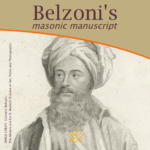 Belzoni's Masonic Manuscript is a valuable resource for anyone interested in the history and practices of Freemasonry, as well as for those interested in the broader cultural and social history of the early 19th century. The manuscript provides a rare glimpse into the inner workings of the organization, and offers insights into its beliefs, values, and practices. It is a fascinating document that continues to captivate and intrigue scholars and freemasons alike. |
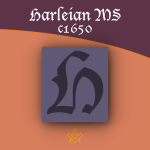 There are two known 'Harleian Manuscripts' which allude to the earliest constitutions of Masonry. |
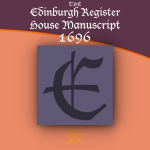 The Edinburgh Register House Manuscript (1696) At the time the manuscript was written in Edinburgh, Scotland was the home to various lodges, including those of the operative Masons of Edinburgh, it provides an interesting Masonic Catechism with questions and answers, a genuine ritual of admission. |
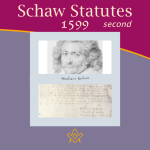 The Second William Schaw Statutes (1599) We look at a modern transcript of the second William Schaw Statutes dated 1599. An operative masons charter for stone cutters and layers in the building industry of the time. A set of rules and regulations including penalties. |
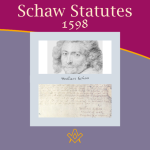 The First William Schaw Statutes (1598) We look at a modern transcript of the first William Schaw Statutes dated 1598. An operative masons charter for stone cutters and layers in the building industry of the time. |
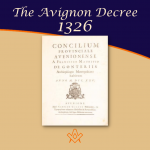 The Avignon Decree (1326) Papal Bull The several Papal declarations against Freemasons after the formation of the Grand lodge in England in 1717 are well known. The Avignon Decree (1326), published 400 years prior, is the earliest known document to set out the Catholic Church's intentions… |
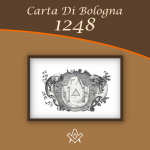 The Bologna Statutes Or Carta Di Bologna The Bologna Statutes or Carta Di Bologna 1248 - Masonic document of Operative Masonry, the oldest one found to date. |
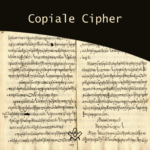 What is the connection between the Copiale Cipher and the great enlightened society of oculists ? |
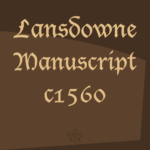 A very foolish legendary account of the origins of the Order of Freemasonry |
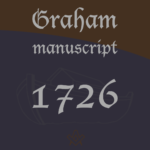 The Graham Manuscript dating from 1726 is an early Masonic document that calls upon Noah and this 3 sons in respect to Masonry, an alternative allegory to the Hiram legend. |
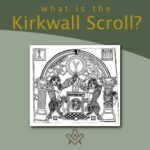 The Kirkwall Scroll is a hand-painted floor cloth depicting a myriad of symbolism |
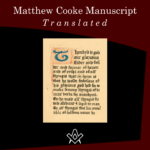 Matthew Cooke Manuscript was written c1450. A transcript of a yet older document, written by a Speculative Mason |
 Are you interested in the 'musty old documents of the past'? This article first appeared in The Builder magazine,1923 |
masonic knowledge
to be a better citizen of the world
share the square with two brothers

click image to open email app on mobile device









